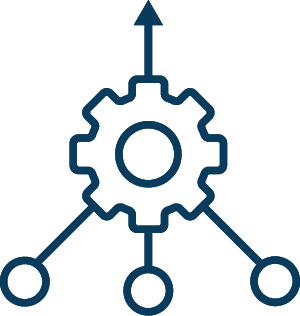How IT Due Diligence 2.0 Maximizes Value in M&A Transactions
How IT Due Diligence 2.0 Maximizes Value in M&A Transactions
Conventional IT due diligence revolves around compliance, risk mitigation, and identification of costly issues. While these aspects are fundamentally important, they represent only a fraction of the value that a growth-minded approach to IT due diligence can deliver. When positioned uniquely, IT due diligence becomes a strategic diligence capability that uncovers opportunities to accelerate topline growth, enhance the customer experience, and fast-track value realization.
In our experience, IT is the #1 enabler of value-creation playing a critical role in realizing deal synergies. By adopting a growth mindset during the diligence process, IT diligence can uncover competitive advantages and unique capabilities that can foster innovation and collaboration, where teams are motivated to explore creative solutions that optimize their technology investments, contributing to long-term, sustained growth.
IT Due Diligence 2.0: A Growth Minded Approach
Technology-enabled value creation in M&A is no longer an option but a strategic imperative. As companies continue to rapidly embrace digital technologies and artificial intelligence, the distinction between business strategy and technology blurs. In this transformative digital landscape, IT due diligence 2.0 emerges as a pivotal driver for achieving enhanced value. Let’s delve into the key elements of the approach.
 1. Topline Growth
1. Topline Growth
The foundation for achieving topline growth through IT due diligence 2.0 begins with a clearly defined investment thesis, validated during diligence, and executed following deal close. While growth aspirations can be modelled effectively, the imperative is to understand how the levers of business development, customer engagement and revenue operations can or are being exploited with technology to grow topline revenue. This IT due diligence 2.0 approach emphasizes understanding the unique capabilities within a sales organization, positioning them to create a competitive advantage. Departments often will design processes tailored to client needs, fostering increased customer engagement and trust in the company. IT due diligence 2.0 recognizes the importance of preserving these processes while also understanding how to scale and integrate them with another set of technologies and capabilities from the buyer. For IT due diligence 2.0 to be effective, diligence needs to take the added step of understanding how systems are designed, how data flows between systems and customers and how internal and external stakeholders interact to create a seamless journey.
IT due diligence 2.0 goes beyond assessing current systems; it dives into the innovative potential of the target company’s technology which can drive topline growth. By identifying unique capabilities, emerging technologies, or untapped intellectual property, buyers can leverage these innovations to gain a competitive edge. This focus on technology synergies can drive long-term value creation by positioning the platform or merged entity as a leader in innovation.
 2. Customer Experience
2. Customer Experience
Embracing a customer-centric approach, IT due diligence 2.0 understands the uniqueness in the customer journey, how technology enables seamless touchpoints, and how customers engage in collaboration. With this understanding, the buyer can strategically tailor their integration by developing a strategy to unify customer touchpoints across channels, aligning both the buyer’s and the target’s engagement strategy. This alignment not only fosters a cohesive brand experience but significantly contributes to increased customer satisfaction and loyalty.
Ultimately, creating a better customer experience leads to greater opportunities to cross-sell and upsell products and services, but in a way that customers recognize the value being offered by the merger. Gaining customer confidence early in the process helps to retain customers, revenue and expose additional opportunities for collaboration.
In addition to the external customer experience, synergies also extend to the cultural aspects of the target company’s IT team and internal customer experience. Understanding how teams collaborate, share knowledge, and approach problem-solving fosters a culture of innovation and adaptability. This cultural alignment contributes to a smoother post-merger integration and better internal customer experience, where IT professionals from both companies can collaborate effectively, leading to enhanced productivity and creativity.
 3. Value Realization: Data Monetization Strategies
3. Value Realization: Data Monetization Strategies
An in-depth examination of the target company’s data assets during diligence reveals opportunities for data monetization. By identifying valuable datasets, customer insights, or unique data-driven services, the buyer can understand the potential to create new revenue streams and enhance the financial performance of the merger. This focus on data-driven value creation aligns with the growing importance of data in today’s business landscape.
IT due diligence 2.0 evaluates the current and potential use of advanced analytics on the company’s data assets to provide a deeper understanding of customer behavior. While the target may not have these capabilities, the buyer should approach diligence with the intent to comprehend how high-quality data can be used to predict trends and provide data-driven forecasts, empowering the buyer to make better, more informed decisions.
Additionally, IT due diligence 2.0 aids the buyer’s understanding of how or if the target is leveraging customer and market data for targeted marketing and product or service offerings. A detailed analysis of customer feedback, if available, can provide valuable insights that reinforce or contradict the investment thesis. Understanding the target’s use of customer and market data to make informed product, service, and marketing decisions provides confidence to the buyer about the potential to accelerate growth upon close and how technology plays a key role.
 4. Cybersecurity and Brand Trust
4. Cybersecurity and Brand Trust
Cybersecurity is a salient concern that permeates across all businesses, not only for risk management, but for the increasingly critical factor of brand trust. Many firms experience ransomware attacks shortly after announcement, which has an immediate impact on customer trust and deteriorates value almost immediately, making cyber diligence imperative.
While various aspects of cyber diligence are crucial, one often overlooked element is the understanding of cybersecurity and data protection commitments within customer contracts. While unorthodox, a review of customer contracts is vitally important to ensure buyers can take on the responsibility for their customer’s requirements ranging from protecting data to ensuring cyber resiliency and having business continuity capabilities that are documented and practiced. Additionally, cybersecurity insurance is another critical area to investigate, as many firms are commonly underinsured in the event of a cyber incident.
A comprehensive evaluation of cybersecurity practices not only exposes potential risk but can also be leveraged as a source of value creation. A robust cybersecurity posture enhances the trust of customers and stakeholders and serves as a market differentiator. Communicating a strong commitment to data security and privacy can contribute significantly to brand value and customer loyalty. This proactive cybersecurity approach positively impacts the overall perceived value of the merger.
 5. Crafting an Actionable Roadmap
5. Crafting an Actionable Roadmap
IT due diligence 2.0 serves as a catalyst to identify risks and to craft a clear and actionable investment plan and roadmap. This strategic plan aims to enhance the target’s IT capabilities and scale to achieve the deal thesis. This roadmap includes a prioritized list of initiatives with detailed timelines, ensuring that the acquirer can adeptly address any IT-related issues and optimize the target’s technology environment.
The roadmap and projects developed should include details of tangible, quantifiable, time-based, and resource estimated initiatives that will enable the acquired company to make immediate progress towards value creation within the first 100 days post close.
IT Due Diligence 2.0 as a Strategic Tool
IT due diligence 2.0 represents a paradigm shift in M&A strategies, transcending traditional compliance-focused approaches. This growth-minded methodology positions IT diligence as a strategic enabler, uncovering opportunities to accelerated topline growth, enhanced customer experiences, and expedited value realization. As technology becomes inseparable from business strategy, IT due diligence 2.0 emerges as a vital driver in navigating the digital landscape.



